Thinning an oak woodland
Why grow trees only to cut them down? There's a reason we do that – it makes the trees bigger.
Now that my doors are open for business, I’m starting to take a range of work. Domestic arboricultural (arb - aka tree surgery) work is the bread and butter type of work, but there’s other kinds of work I seek out. One of them is woodland work – aka forestry. Most people pick a team (arb or forestry) and stick to that team for their career. The forestry people tend to think that the arb people are prima donnas who take eons to remove a tree and the arb people think that the forestry people are luddites who can do nothing other than fell trees.
I really don’t have a team. There’s joy (and pain) to be had in both worlds. So when the opportunity came to take on a thinning job for two days a month for as long as it takes to get through 65 acres, I was all over it. The woodland is in Northumberland, somewhere off the A68. Twenty years ago this woodland was nothing but a sheep grazing field. Today it’s ready for it’s first thinning.
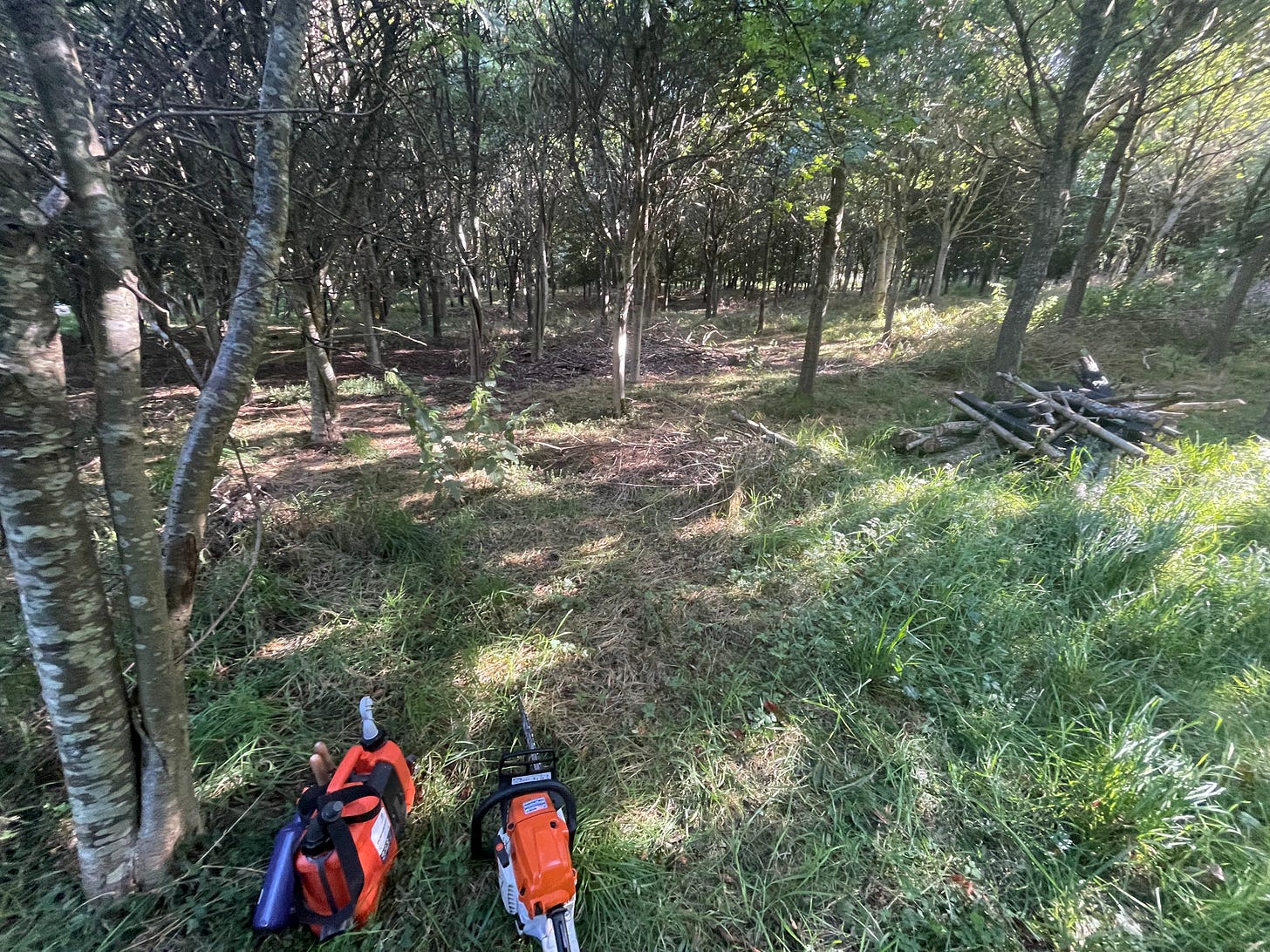
I arrived on-site for 8:30 and the owner met me there. We ran through the plans and the spec. It was pretty straight forward. I was to work a section called the top field and remove everything marked with a yellow dot. Stems were to be snedded and the brash left in piles where it fell. Logs to be cut to metre long lengths and stacked in groups to make harvesting as easy as it can be. These logs were all destined for firewood as they’re too small for proper woodwork. There’s little heartwood in the trunks at this age and oak is all about the heartwood.
But how do you decide what trees to remove? That’s a good question to ask. Allow me to demonstrate. Below are three marked trees from within the same area. The one on the left was selected because it was twisted. That twist will never go away and it’d make for an awful bit of timber. No one would enjoy working that wood. The centre image shows an oak that has decided to create significant bend in the stem. Whilst the grain may be ok in the resulting timber, there’d be little to mill because of the bend. Finally on the right you can make out the twin leader habit the tree has decided to adopt. Whilst the timber may have “character”, there’d be little of it and there’s a likelihood that the tree would split or be lost to storm damage. In short, none of these trees had good genetics. So they had to go.
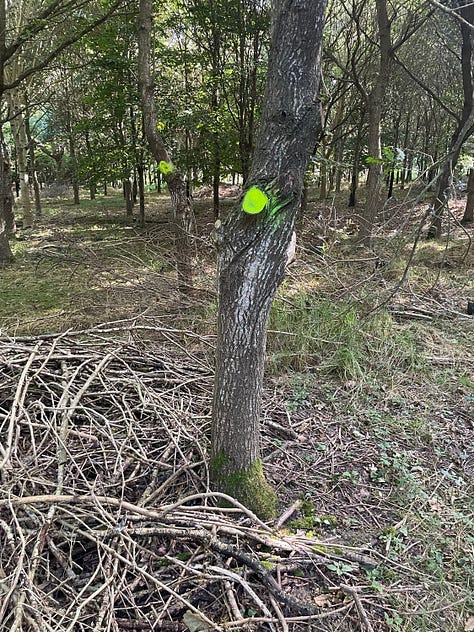
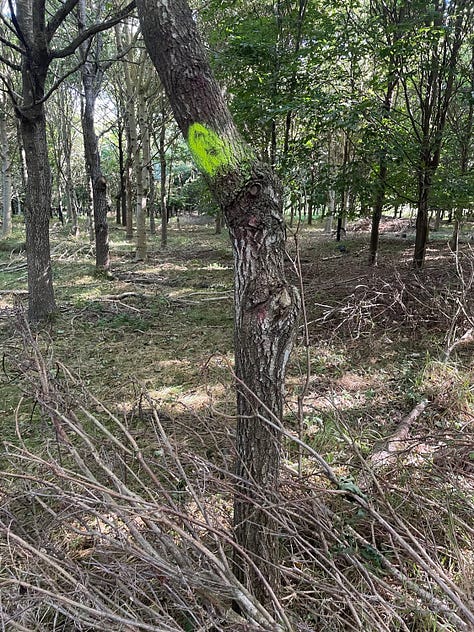
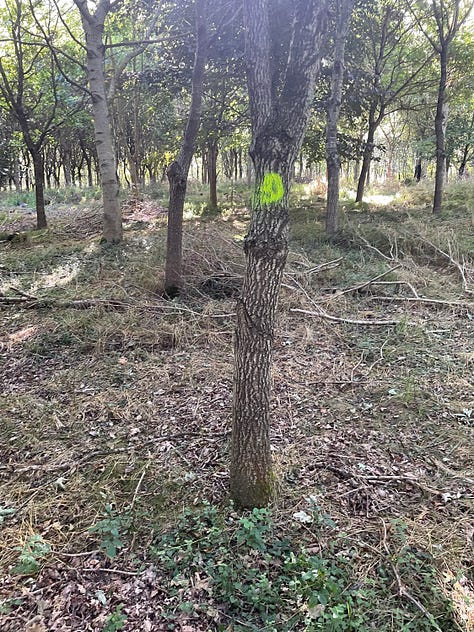
By thinning the amount of trees in a given area, you remove competition for resources. There’s more light, water and nutrients for less trees. That directly translates to more growth on the trees with favourable genetics and that dear reader, directly translates into a better payout for whomever owns the woodland in the year 2140. Yes, that’s correct, twenty one fourty. Oak takes a minimum of one hundred and twenty years to reach harvest. I’ll be LONG dead by then.
Below you can see the area where the above three trees were removed. That gap will soon close up over the coming years and the resulting foliage will power the expansion in girth of all of the trees you can see in the photos.
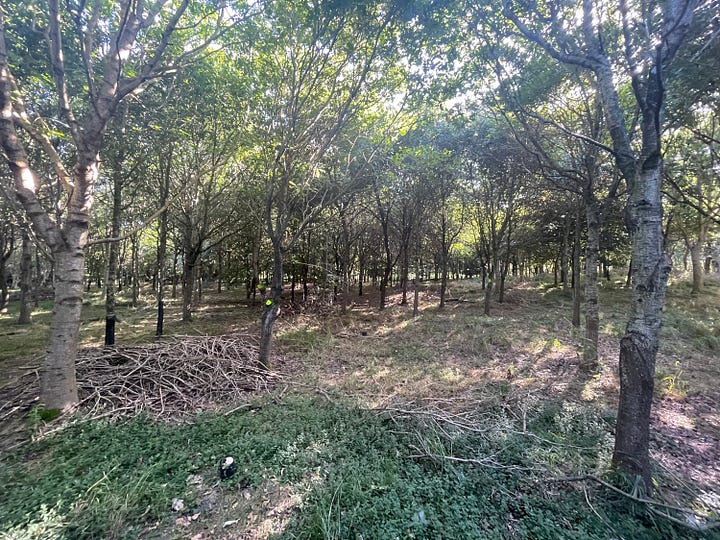
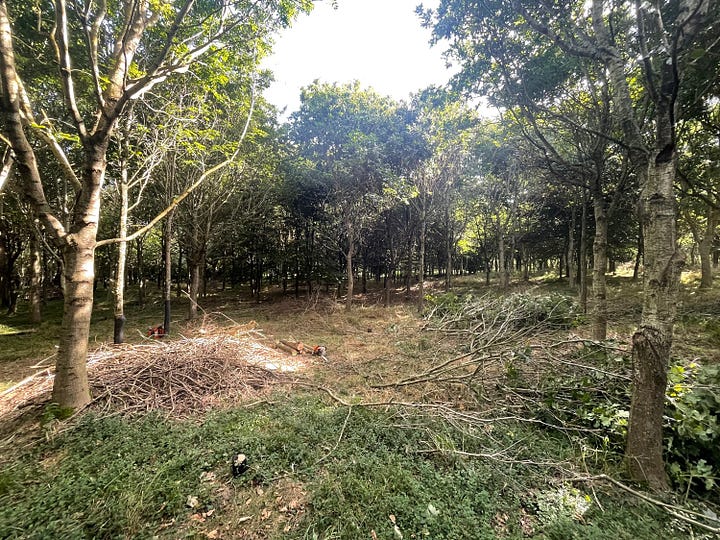
One of the challenges in doing a “first thin” is that most trees will get hung up when you fell them. This can be avoided to some extent by capitalising on gaps in the canopy and using certain felling techniques to get trees to fall into opened spaces. I found myself using a felling technique called the “split level” a lot when working this site. You’d use this technique when you want a tree to go in the exact opposite direction that gravity wants it to. When you’re working trees this size, you cannot use wedges as there’s not enough room, so you use a felling lever. I don’t want to digress into a discussion of the split level technique, so I will simply show you one I performed quite well except for one critical error. Ten points if you can spot the mistake.
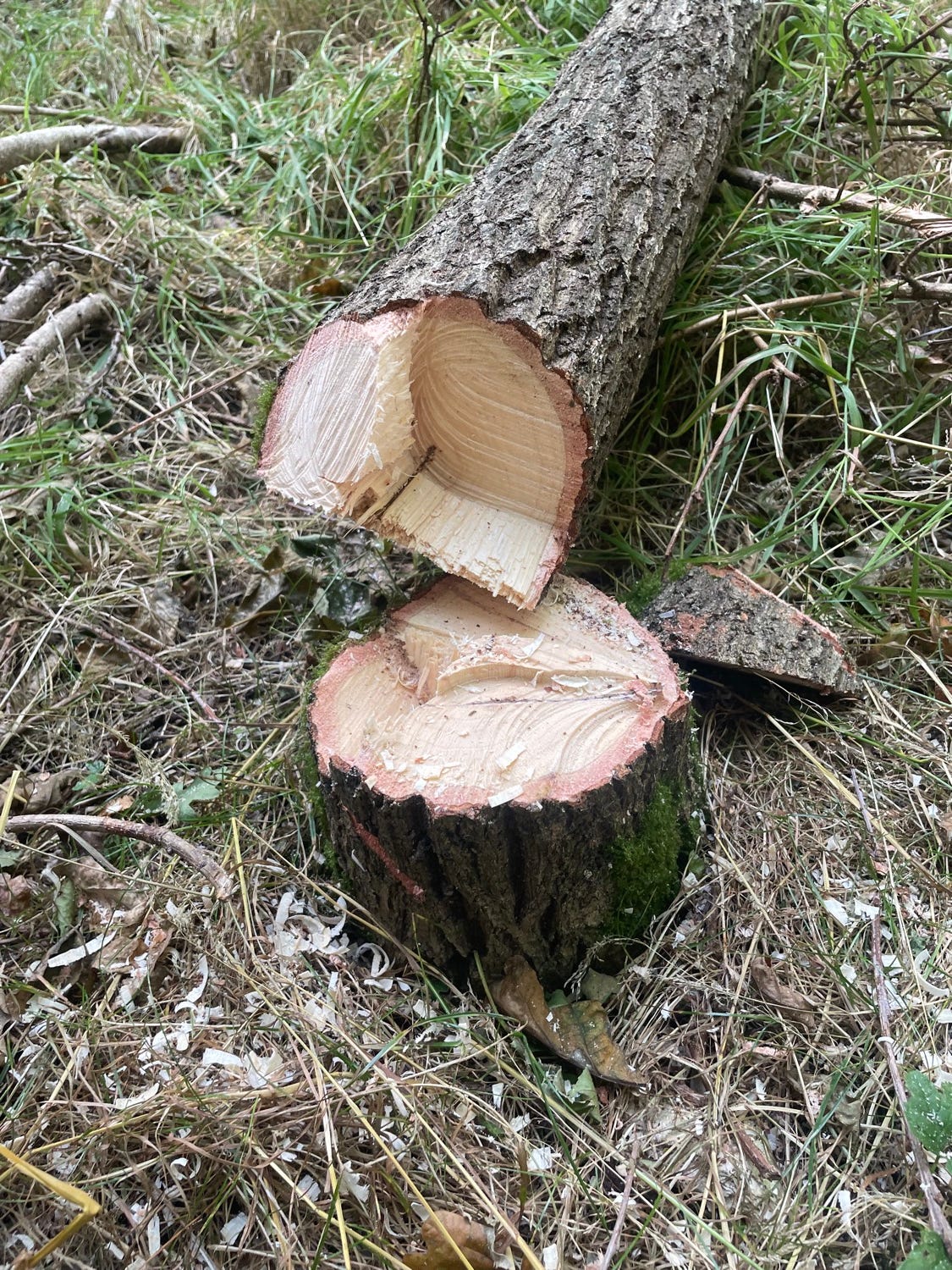
One of the things the gaffer at the estate gives me grief for is leaving a high stump. On the above example that stump is too high. You may not think so, but when you’ve burst a tractor tire on something like this, or tripped up on it when planting trees you begin to develop a very low tolerance for any stump that sticks up in any way, shape or form. If this was a timber tree and a final felling I should have been shot for leaving that much wood on floor. Every inch matters in forestry (that’s what she said ) because you’re not getting paid for anything other than the logs you produce. If you leave four inches on a stump, that’s money you’ve wasted. Needless to say, I went back and cut the stumps down to ground level whilst doing my absolute best to keep my chain out of the dirt. Nothing blunts a chainsaw faster than hitting dirt. Even a tiny contact can cause you to have to stop and resharpen.
Once I hit my stride, my stumps got constantly lower and I got faster and faster. Lunch came around quickly and I was famished. My lunch on that day was a homemade flatbread with melted cheese and bacon. Greggs bacon and cheese wraps have nothing on these. All washed down with a coffee to re-caffinate me for the rest of the day. One of the more pleasant things about this kind of work is all the nature and ecology. On my way back to the saw after lunch I noticed a few of these “oak apples”. Do not eat the oak apples. They are wasp eggs.
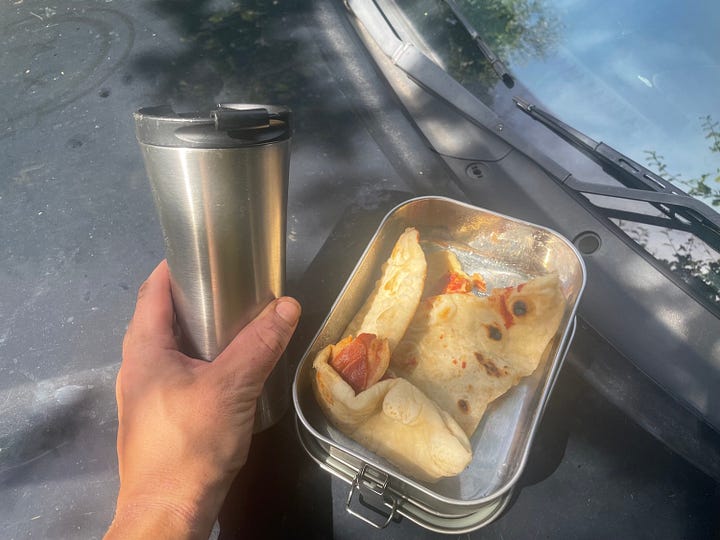
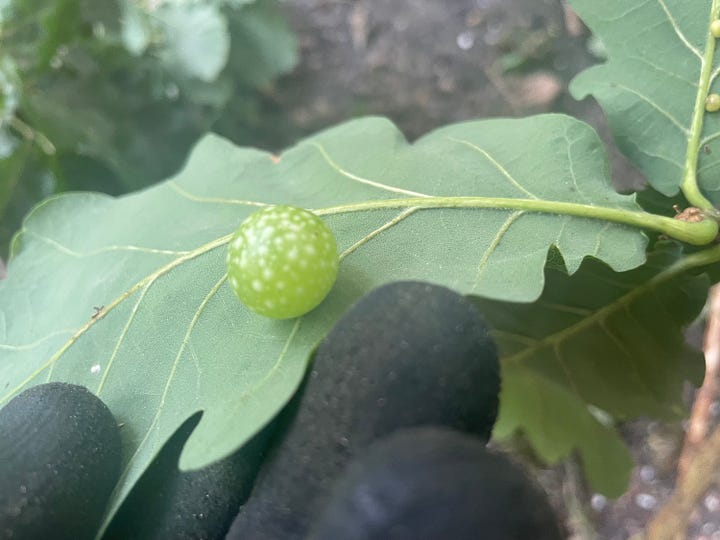
I absolutely hammered the afternoon and when I called it a day at 3:30 I’d felled and processed one tree every nine minutes for a total of 33 trees. When I think back two years to that that period of time in treeschool when we first felled trees, it was taking me nearly forty minutes to do a single tree. I’d say nine minutes is a nice improvement.
I must have done something right because the owner has asked me back in two weeks time. Only next time I’ll be doing some high pruning as well as thinning. All in all it was a lovely days work in a stunning location on a beautiful day. It’s something to think that when these trees reach maturity and are ready for harvest I probably would have been dead for at least half a century.
As I was just the hired help, no one will ever know. Except me and the trees. That’s the thing with this line of work, it’s personal between you and the trees.
I appreciate your attention.
Thanks for reading,
Cheers,
Jamie.


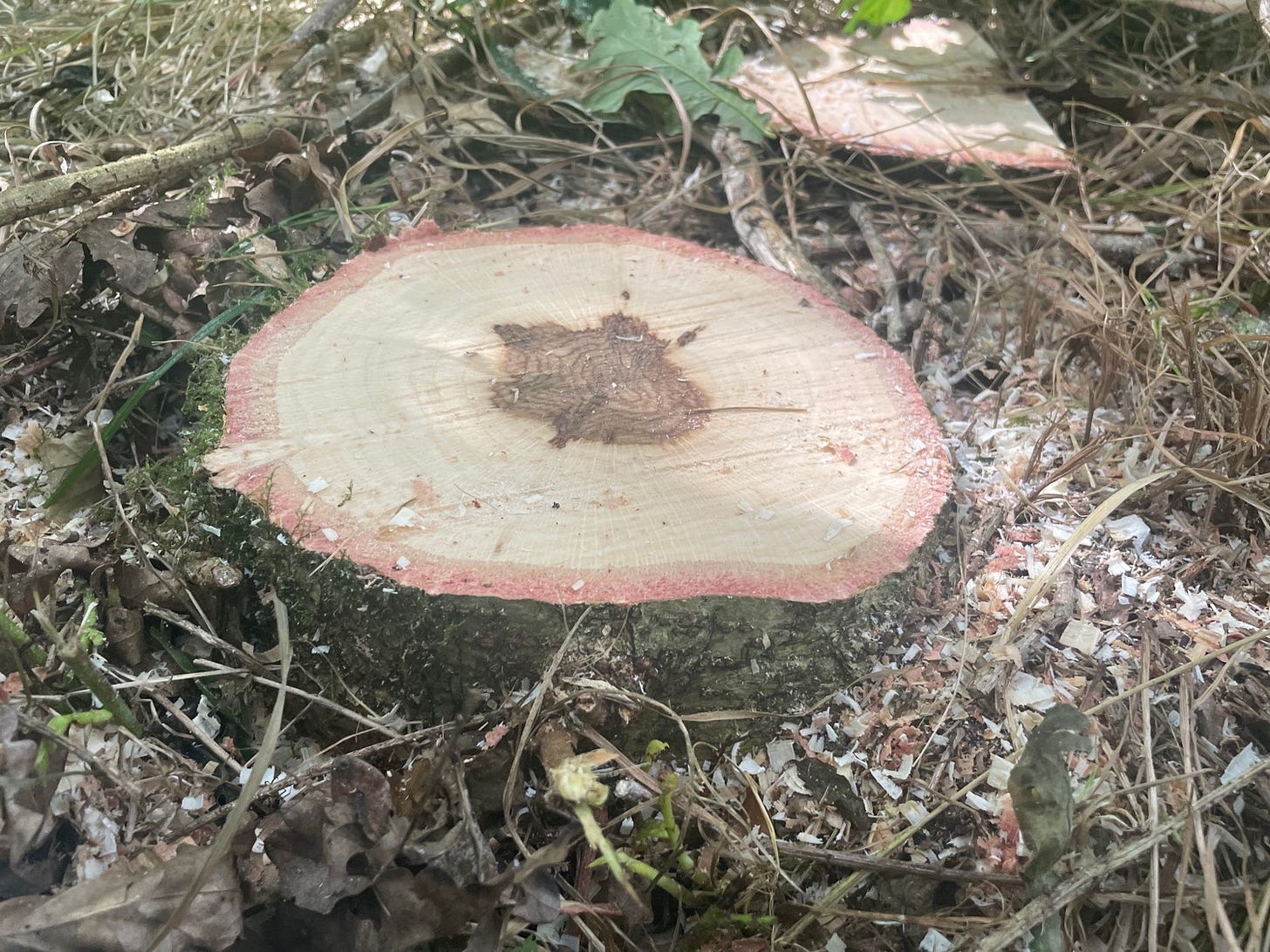
An enjoyable read, thx. Are the trees in rows? If so it’s a tree farm specifically for lumber? That’s nice new gear you have. Just this year I went to canned gas mix. As our local Stihl dealer says “it’s the only way to go.” Maybe unless you’re going thru a lot of gas.